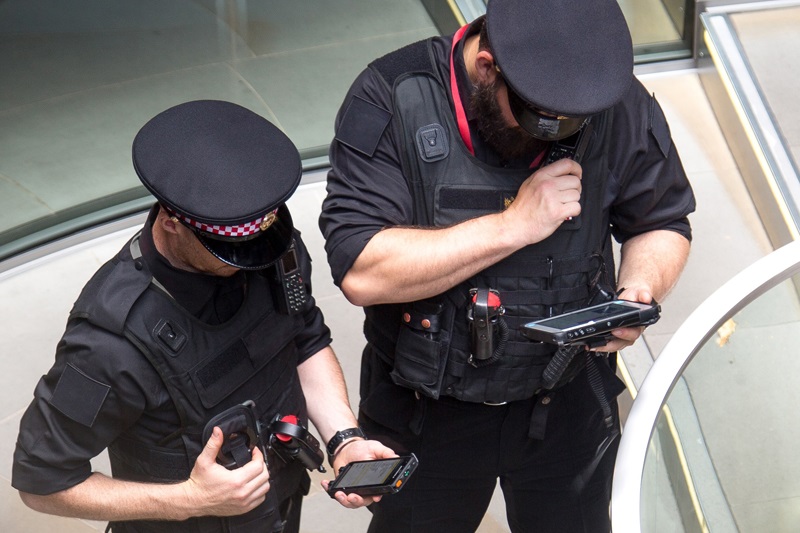
Protecting residents, workers, visitors, and businesses in the famous “Square Mile” is the mission for the City of London Police

The Greater London area is a sprawling metropolis, with a population of more than 14 million. But the City of London itself is just 1.12 square miles with about 8,000 residents. Known as the “Square Mile,” the City is London’s primary business district and a major financial centre that’s home to the Bank of England and the London Stock Exchange.
The City of London Police protects the City’s residents, visitors, workers, and businesses, and the agency has seen its share of high-profile criminal acts since its founding in the 1830s. Those notorious crimes include the Jack the Ripper murders in the late 19th century, the Irish Republican Army’s bombings in the City during the decades of “the Troubles,” and the 7/7 Islamist suicide attacks in 2005.
“You can imagine the significance of the Square Mile to those who wish to commit high-profile crimes against the United Kingdom as a nation,” says Paul Dainty, Forensic Manager for the City of London Police. “Our agency, alongside the Metropolitan Police, have a heightened level of security around counterterrorism. And we’re briefed regularly by security and intelligence services MI5 and MI6 about the status of threat levels.”
Pressure to move fast, be present and manage expectations
The City of London Police has more than 1,000 law enforcement officers and staff. It’s separate from the massive Metropolitan Police, aka Scotland Yard, which handles law enforcement in 32 London boroughs and protects the Palace of Westminster, Heathrow Airport, and much more. Paul says that in addition to counterterrorism activities, the agencies collaborate on anti-knife crime initiatives. The City of London Police also leads nationally on investigating fraud and economic crime.
In short, there’s a great deal for the agency to do, around the clock, to help keep people and businesses within the Square Mile safe. Practicing intense vigilance for possible danger, taking swift action in investigations, and gathering solid evidence, including Digital Intelligence, to make arrests and support prosecutions are all essential tasks for the City of London Police. But limited resources often make a tough job even harder for the agency, including its Forensics Services Department.
“We have finite resources, and every request is urgent,” says Paul, who manages the Fingerprint Enhancement Laboratory, the Fingerprint Bureau, and the High-Tech Crime Unit for the department. “Quite a lot of my day is spent fielding inquiries about what we can and can’t do — and whether people should even submit casework to us — because we don’t have the time or capabilities. I’m often taking phone calls from officers who’ve turned up at a crime scene with no digital strategy who suddenly found they were confronted with technology they don’t know what to do with. So, they call us.”
“The department has long used Cellebrite tools to access and collect data from devices lawfully. But as the number of devices per investigation has increased, and with many devices now featuring sophisticated encryption, investigators’ need for advanced tools has grown exponentially,” says Paul.

A lucky turn that could easily have been a miss
One recent, urgent call from the field helped accelerate the decision by the City of London Police to find a way to equip its High-Tech Crime Unit with more advanced technology to access devices — and become even more effective in helping the agency meet its mission to keep the City and its population safe. The case involved a large cannabis farm operated by an organized crime group. Investigators executed a warrant to search the property and found not only evidence of the drug operation, but also “routers galore, cables running through ceilings, and digital devices here, there, and everywhere — many of them encrypted,” says Paul.
Investigators with the High-Tech Crime Unit applied Cellebrite access solutions to the only unencrypted mobile device found on the scene and, luckily, collected ample digital evidence to advance the investigation. “That unencrypted device we accessed was massively key, particularly in terms of messaging between suspects and timelines and identifying the chain of command,” says Paul. “And while investigators were still examining the scene, we had already sent the report back to the investigative team for review. That quick intelligence let them say to the suspects, who weren’t cooperating, ‘Hey, we know Person A is the big boss.’”
The law enforcement agency lacked the ability to legally access encrypted Android devices quickly and efficiently — and without luck being on investigators’ side, the drug farm investigation could have stalled or fallen apart. The investigators may not have been able to identify the “big boss” behind this organized crime activity, for example, and confidently present that information to the uncooperative suspects. Consideration of these and other facts ultimately led the department to adopt Cellebrite solutions and services.
The Forensic Services Department also now looks to further its own digital transformation efforts so it can become even more efficient in its work to help make the City of London safer. “We spent the last year conducting a massive, detailed design review for all of forensics — one strand of which is ‘digital investigation,’” says Paul, who leads discussions about digital strategy for the department. “We identified several significant changes we need to make to service the types of crimes we investigate. The ability to legally deal with Android and iOS decryption is part of that model. So, implementing Cellebrite solutions is the start of that journey for us.”
To see how other agencies around the world are harnessing the power of digital technology to protect and save lives, accelerate justice, and preserve data privacy click here.
About the Author: Sean Millwaters is a Digital Intelligence expert with more than 13 years of combined military and police experience. In his previous profession, he was a member of various law enforcement squads involved with drugs, surveillance, and armed response.
Sean has more than 20 years of sales experience working with law enforcement, government, and military agencies. For the past seven years, he served as Sales Director/Senior Sales Director, VP Sales UKI, and VP Sales EMEA for Cellebrite.